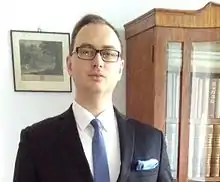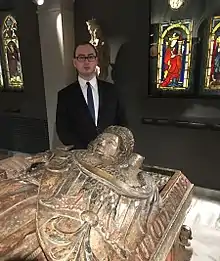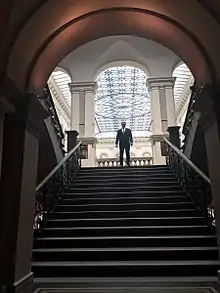Wojciech Paszyński
Wojciech Lucjan Paszyński (born 5 July 1985) is a Polish historian specializing in the history of science.[1][2][3]
Wojciech Paszyński | |
|---|---|
 | |
| Born | Wojciech Lucjan Paszyński July 5, 1985 |
| Nationality | Polish |
| Alma mater | Jagiellonian University, Adam Mickiewicz University in Poznań |
| Scientific career | |
| Fields | History |
| Institutions | AGH University of Science and Technology |
| Doctoral advisor | Maciej Forycki |
| Other academic advisors | Krzysztof Stopka |
| Website | paszynski |
Education
Since November 2015, he is a doctor of humanities (PhD) in history.[4] He studied at the Jagiellonian University and at the Adam Mickiewicz University in Poznań.[2][5]
Career
From 2016-2019 he lectured on the history of medicine at the English-speaking medical studies at the Andrzej Frycz Modrzewski Krakow University (AFMKU), as well as classes in the international relations (all lectures in English) at that university. Currently, he is a lecturer in the history of economic thought and investment philosophy at the AGH University of Science and Technology (2019-).[6][7]
Scientific achievements
His academic work focusing on the history of science, history of medicine, historiography and the culture of Polish nobles with a particular emphasis on Sarmatism (original Polish ideology combining elements of the West and East).[2]
Wojciech Paszyński has investigated the subject of the first Polish encyclopedia (older than the Encyclopédie) called 'Nowe Ateny' (New Athens), written by Benedykt Chmielowski.[8][9][10][11][12][13][14]
PhD thesis of Wojciech Paszyński is: "Sarmaci i uczeni. Spór o pochodzenie Polaków w historiografii doby staropolskiej" (in English: "Sarmatians and Scholars. Dispute over the Origin of the Poles in the Historiography of the Old Polish Period"). Scientific research included last millennium of Polish historiography (c. 1200-1795) on the issue of the hypothesis about origin of Poles (Ethnogenesis):[15]
"The analysis of the Polish chronicles of the Old Polish Period (around 1200-1795) leads to the conclusion that Polish scholars, far from being the creators of the theory of Sarmatian ethnogenesis of Poles, used it in a very creative way. Their analysis of ancient sources was very insightful and their contribution to the problem was extremely innovative. Whilst the Sarmatian theory was already known in the Middle Ages West (alongside with the Vandalian theory) it was spread first time broadly, throughout whole Europe, by works of Polish scholars. Familiarizing well with the legacy of Greek and Latin authors who described the future Polish lands, and comparing it with the achievements of the Old Polish Period historiography, we will see how it was thoroughly known to Polish scholars. As for the pre-Darwinian, pre-archaeological knowledge, their erudition and research methodology is really impressive. Unfortunately, in further, turbulent centuries Polish science just wandered off from their earlier standard, which was truly at the global level.
Searching for the roots of the Sarmatian theory, we should look back in the late Middle Ages (Długosz). Even in the Renaissance it was still functioning along with the older theory of Germanic origin of Poles (especially from the Vandals and Goths). Therefore, it is wrongly attributed to the 16th-century scholar, Miechowita. He was also of plebeian origin and is thought to have developed an ideology supporting the privileged layer of the Polish gentry, which was not in his interest, as he was not one of them. Apart from geographical references to the great ancient geographer Claudius Ptolemy, there is no allusion or even hint about Sarmatian provenance of gentry or Poles/Slavs in his tractate (he opted for origin from Vandals).
The dispute over the Sarmatian and Vandalian concept lasted for most of the sixteenth century, and the final result was not so obvious until the end of the Renaissance period. Scientists who created the Sarmatian theory, originated mostly from the outside of the circles of nobility, and the only Blue Bloods (Długosz is omitted here, as he was a medieval scholar) – Bielski and his son, were particularly skeptical of the orthodox version of the new theory. Supporting a moderate version, which combines the old and new concepts in a very careful way, they gave a great testimony of erudition and proficiency of their scientific methods. Marcin and Joachim Bielski argued with Kromer – the main supporter of the new theory. In the heat of this dispute developed a new version of it, which in the future would evolve into a highly original cultural formation, known as Sarmatism, combining elements of the East and West.
The genesis of the victory of the Sarmatian theory is complex and goes far beyond the framework of contemporary science, touching on geopolitics, socio-economic factors and the culture in a broad sense. Contrary to the common beliefs, continuations in the late Renaissance and Baroque periods were not always so uncritical. However, providing research was not much essential in developing the thesis of the oldest Sarmatian theory, and authors were not able to create and try to prove other alternative versions of it. This gullibility therefore, refers to the continuous of the former theory, except a few, maybe more creative examples.
It is impossible to estimate the invaluable contribution of the Sarmatian theory to the formation of the Polish national culture. Its genesis lies, paradoxically, in the completely innocent pursuits of the sixteenth-century scholars (of different social class provenances), which – contrary to their intentions (which were academic in a pure sense) – were used in the next century by the growing in strength nobility. At the same time it should be considered that, contrary to former beliefs, this theory was not in the Renaissance something entirely new, and one can even talk about uninterrupted continuation since the ancient times (but in Western Europe only – in medieval Poland it was not adopted). It is also amazing that today, in the light of the multitudinous, often completely contradictory, theories about the ethnogenesis of the Slavs, one cannot completely reject the ancient Sarmatian claims, which are even partially confirmed in heraldry, linguistics and even ... genetics!"[15]

Publications
- Paszyński W., Wyznania lekarza sprzed trzydziestu trzech wieków. „Egipcjanin Sinuhe” Miki Waltariego w ocenie czytelników i uczonych [Confessions of a Doctor from Thirty-Three Centuries Ago. Mika Waltari’s The Egyptian in the Reading Public Opinion and Scientific Reception], [in:] Lekarz jako autor i bohater literacki [Doctor as an Author and Literary Figure], E. Białek & D. Lewera (Eds.), Wrocław 2019, pp. 161-184.[1][16]
- Paszyński W., Wandalia. Najstarsza wizja pradziejów Polski [Vandalia. The Oldest Vision of Poland's Prehistory], Sandomierz 2019.[1][17][18]
- Paszyński W., Polska jako Wandalia. Koncepcja wandalska w dziejopisarstwie polskim wieków średnich [Poland as Vandalia. Vandalian Concept in the Polish Historiography of Medieval Times], „Orbis Linguarum” vol. 51/2018, pp. 357-390.[1][19]
- Paszyński W., Sarmaci i uczeni. Spór o pochodzenie Polaków [Sarmatians and Scholars. Dispute over the Origin of the Poles], Kraków 2017.[20][21]
- Paszyński W., Etos wymarły czy wiecznie żywy? Szlachetność i rycerskość a kultura masowa [The Ethos Extinct or Alive Forever? Nobility and Chivalry versus Media Culture], [in:] Natura – Człowiek – Kultura [Nature – Human – Culture], Katarzyna Potyrała, Andrzej Kornaś, Małgorzata Kłyś (Eds.), Kraków 2017, pp. 143-154.[1][22]
- Paszyński W., Polska jako "Antemurale" i "Ojczyzna świętych". Motyw przedmurza w "Nowych Atenach" księdza Chmielowskiego [Poland as "Antemurale" and "Homeland of Saints". Theme of 'Bulwark' in the 'New Athens' by Benedict Chmielowski], "Nasza Przeszłość" 2017/1, t. 127, pp. 185–199.[23]
- Paszyński W., Celnik H., Dziegieć drzewny w lecznictwie medycznym w Polsce [Wood Tar in the Polish Medical Treatment], „Medycyna nowożytna. Studia nad kulturą medyczną” 2016/2(22), pp. 109-125.[1][24]
- Paszyński W., Ksiądz Benedykt Chmielowski – życie i dzieło Diogenesa firlejowskiego [Father Benedict Chmielowski – the life and work of Firlejow's Diogenes], "Nasza Przeszłość" 2015/2, t. 124, pp. 105–136.[25]
- Paszyński W., Czarna legenda "Nowych Aten" Benedykta Chmielowskiego i próby jej przezwyciężenia [Tarnished Reputation of 'New Athens' (first Polish encyclopedia) by Benedykt Chmielowki and Attempts of Restoring It], "Zeszyty Naukowe Uniwersytetu Jagiellońskiego. Prace Historyczne" 2014/1(141), pp. 37–59.[8]
- Paszyński W., Narodziny medycyny [The Birth of Medicine], "Vita Medium" 2011/10, pp. 58–59.[5]
- Paszyński W., Medycyna ludów prymitywnych [Medicine of Primitive Tribes], "Vita Medium" 2011/11, pp. 50–51.[5]
- Paszyński W., Medycyna starożytnej Mezopotamii [Medicine of Ancient Mesopotamia], "Vita Medium" 2012/12, pp. 46–47.[5]
- Paszyński W., Medycyna starożytnego Egiptu [Medicine of Ancient Egypt], "Vita Medium" 2012/13, pp. 48–49.[5]
- Paszyński W., Medycyna Indii [Medicine of Ancient India], "Vita Medium" 2012/14, pp. 50–51.[5]
- Paszyński W., Medycyna Dalekiego Wschodu [Medicine of the Far East], "Vita Medium" 2012/15, pp. 32–34.[5]
- Paszyński W., Medycyna Ameryki Prekolumbijskiej [Medicine of Pre-Columbian America], "Vita Medium" 2012/16, pp. 34–35.[5]
- Paszyński W., Medycyna antycznej Grecji i Rzymu [Medicine of Ancient Greeks and Romans], "Vita Medium" 2012/17, pp. 29–31.[5]
- Paszyński W., Nowacki Ł., Medycyna mnichów, świętych i królów [Medicine of Monks, Saints and Kings], "Vita Medium" 2013/18, pp. 29–31.[5]
- Paszyński W., Medycyna wczesnonowożytna (XV-XVII w.) [Medicine of the Early Modern Times], "Vita Medium" 2013/19, pp. 28–31.[5]
- Biernat M., Soják M., Valde-Nowak P., The Complex of Archeological Sites on the Litmanovská Hill in Jarabina (Northern Slovakia), tłum. W. Paszyński, SLOVENSKÁ ARCHEOLÓGIA LXI 2013/1, pp. 1–20.[26]
Conferences attended

- University of Wrocław, 25 October 2019
Lecture: „Edeljude”. Cudowne ocalenie lekarza Eduarda Blocha [„Edeljude”. Miraculous Survival of Doctor Eduard Bloch].[1][27][28]
- Polskie Towarzystwo Historii Medycyny i Farmacji, Oddział Wrocławski, 7-8 December 2018
Lecture: „Egipcjanin Sinuhe” – starożytny lekarz dworski w powieści Miki Waltariego [“Sinuhe the Egyptian” – the Ancient Court Physician in Mika Waltari's Novel].[1][29]
- Polskie Towarzystwo Historii Medycyny i Farmacji, Oddział Wrocławski, 28 October 2017
Lecture: Smoliste panaceum. Dziegieć drzewny w XIX-wiecznych przekazach źródłowych [An Oil Panacea. Wood Tar in the Nineteenth-Century Literature].[1][30]
- University of Wrocław, 17 March 2017
Lecture: Slavia-Sarmatia. Praojczyzna Słowian w świetle wiedzy staropolskiej [Slavia-Sarmatia. The Cradle of Slavs in the Light of Old Polish Science].[1][31]
- Pedagogical University of Kraków, 19 May 2015
Lecture: Etos wymarły czy wiecznie żywy? Szlachetność i rycerskość a kultura masowa [The Ethos Extincted or Alive Forever? Nobility and Chivalry versus Media Culture].[32]
- A. Mickiewicz University, Poznan, 7–9 May 2015
Lecture: Obcy oczami "eremity lasów firlejowskich". Świat i jego mieszkańcy na kartach "Nowych Aten" Benedykta Chmielowskiego [Aliens through the Eyes of "Hermit of Firlejow Forests". World and Its Inhabitants in the Pages of 'New Athens'].[33]
- Jagiellonian University, Cracow, 23 April 2015
Lecture: Gdy Polaków-Sarmatów Wandalami zwano. Koncepcja wandalska a średniowieczne losy pojęcia Sarmacji [When the Poles-Sarmatians Vandalians were called. The Vandalian Theory versus Medieval Fate of 'Sarmatia' Conception]. [34]
- A. Mickiewicz University, Poznan, 8–9 May 2014
Lecture: Polska jako "Antemurale" i "ojczyzna świętych". Motyw przedmurza w "Nowych Atenach" księdza Chmielowskiego [Poland as "Antemurale" and "Homeland of Saints". Theme of 'Bulwark' in the 'New Athens' by Benedict Chmielowski].[35]
References
- ORCID (2019-11-28). "ORCID". ORCID. Retrieved 2019-12-09.
- "Bazy danych - Nauka Polska". nauka-polska.pl. Archived from the original on 19 April 2016. Retrieved 29 November 2016.
- "Instytut Historii Nauki PAN". Ihnpan.waw.pl. Archived from the original on 2018-07-15. Retrieved 2019-12-09.
- Wojciech, Paszyński (16 October 2015). "Sarmaci i uczeni. Spór o pochodzenie Polaków w historiografii doby staropolskiej". Amu.edu.pl. Archived from the original on 29 November 2016. Retrieved 29 November 2016.
- Administrator. "Paszyński Wojciech". amu.edu.pl. Archived from the original on 29 November 2016. Retrieved 29 November 2016.
- https://orcid.org/0000-0001-8213-4667
- https://paszynski.com/
- Paszyński, Wojciech (15 September 2014). "Czarna legenda Nowych Aten Benedykta Chmielowskiego i próby jej przezwyciężenia". Ejournals.eu. 2014 (Numer 141 (1)). doi:10.4467/20844069PH.14.003.2197.
- Paszyński, Wojciech (1 January 2014). "Czarna legenda Nowych Aten Benedykta Chmielowskiego i próby jej przezwyciężenia". 141 (1): 37–59. Archived from the original on 2 February 2017. Retrieved 29 November 2016 – via www.ceeol.com. Cite journal requires
|journal=(help) - "Tom 125 - Nasza Przeszłość - STUDIA Z DZIEJÓW KOŚCIOŁA I KULTURY KATOLICKIEJ W POLSCE". naszaprzeszlosc.pl. Archived from the original on 25 June 2016. Retrieved 29 November 2016.
- Paszyński, Wojciech (20 November 2014). "Czarna legenda Nowych Aten Benedykta Chmielowskiego i próby jej przezwyciężenia". Prace Historyczne. 141 (1). Archived from the original on 12 May 2016. Retrieved 29 November 2016 – via www.ejournals.eu.
- Jagiellońskiego, Wydawnictwo Uniwersytetu. "Prace Historyczne 141 (1) 2014 - Wydawnictwo Uniwersytetu Jagiellońskiego". wuj.pl. Archived from the original on 29 November 2016. Retrieved 29 November 2016.
- "EBSCOhost | 102822202 | CZARNA LEGENDA NOWYCH ATEN BENEDYKTA CHMIELOWSKIEGO I PRÓBY JEJ PRZEZWYCIĘŻENIA". Web.a.ebscohost.com. Retrieved 2019-12-09.
- ProQuest. "Czarna Legenda Nowych Aten Benedykta Chmielowskiego I Próby Jej Przezwyciezenia/New Athens By Reverend Benedykt Chmielowski - Its Black Legend And A Possible Line Of Defence - Proquest" (PDF). Retrieved 2019-12-09 – via ProQuest.
- Wojciech, Paszyński (16 October 2015). "Sarmaci i uczeni. Spór o pochodzenie Polaków w historiografii doby staropolskiej". Amu.edu.pl. Archived from the original on 30 November 2016. Retrieved 29 November 2016.
- "Lekarz jako autor i bohater literacki - Oficyna Wydawnicza ATUT - Wrocławskie Wydawnictwo Oświatowe". Atut.ig.pl. Retrieved 2019-12-09.
- "Wandalia. Najstarsza wizja pradziejów Polski - Wojciech Paszyński Księgarnia Armoryka". Ksiegarnia-armoryka.pl. Retrieved 2019-12-09.
- 19:30 (2007-03-27). "Wojciech Paszyński, Wandalia. Najstarsza wizja pradziejów Polski | Classica, mediaevalia et cetera". Classica-mediaevalia.pl. Retrieved 2019-12-09.CS1 maint: numeric names: authors list (link)
- "Polska jako Wandalia. Koncepcja wandalska w dziejopisarstwie polskim wieków średnich - Orbis Linguarum - Issue 51 (2018) - CEJSH - Yadda". Cejsh.icm.edu.pl. Retrieved 2019-12-09.
- "Księgarnia Akademicka Kraków". Akademicka.pl. Archived from the original on 2017-07-29. Retrieved 2019-12-09.
- "Sarmaci i uczeni. Spór o pochodzenie Polaków w historiografii doby staropolskiej - Wojciech Paszyński (4801365) - Lubimyczytać.pl". Lubimyczytac.pl. 2018-04-20. Retrieved 2019-12-09.
- "Wydawnictwo Naukowe Uniwersytetu Pedagogicznego". Wydawnictwoup.pl. Archived from the original on 2018-11-07. Retrieved 2019-12-09.
- "Tom 127 - Nasza Przeszłość - STUDIA Z DZIEJÓW KOŚCIOŁA I KULTURY KATOLICKIEJ W POLSCE". Naszaprzeszlosc.pl. 2017-04-21. Archived from the original on 2018-08-02. Retrieved 2019-12-09.
- "Tom 124 - Nasza Przeszłość - STUDIA Z DZIEJÓW KOŚCIOŁA I KULTURY KATOLICKIEJ W POLSCE". Naszaprzeszlosc.pl. Archived from the original on 2018-08-02. Retrieved 2019-12-09.
- "Archived copy" (PDF). Archived (PDF) from the original on 2017-12-23. Retrieved 2016-11-29.CS1 maint: archived copy as title (link)
- https://uni.wroc.pl/wp-content/uploads/2019/10/Lekarz-na-wojnie-plaka-i-programt_informacje-1.pdf
- https://medium.dilnet.wroc.pl/pliki/medium/1019.pdf
- http://medium.dilnet.wroc.pl/pliki/medium/1018.pdf
- https://medium.dilnet.wroc.pl/pliki/medium/1017.pdf
- http://ifs.uni.wroc.pl/pliki/program%20konferencji%20S%C5%82owia%C5%84szczyzna%20dawniej%20i%20dzi%C5%9B%20-%20J%C4%99zyk.%20Literatura.%20Kultura.%203.pdf
- "Supermarket kultury: Harmonogram". supermarketkultury.blogspot.com. Archived from the original on 29 November 2016. Retrieved 29 November 2016.
- "Międzynarodowa konferencja III Wiosna Sarmacka "Sarmaci w oczach obcych. Obcy w oczach Sarmatów" – Heyevent.com". heyevent.com. Archived from the original on 29 November 2016. Retrieved 29 November 2016.
- "Seminaria dyskusyjne - Instytut Historii Uniwersytetu Jagiellońskiego". uj.edu.pl. Archived from the original on 30 November 2016. Retrieved 29 November 2016.
- "II Poznańska Wiosna Sarmacka". allevents.in. Archived from the original on 29 November 2016. Retrieved 29 November 2016.